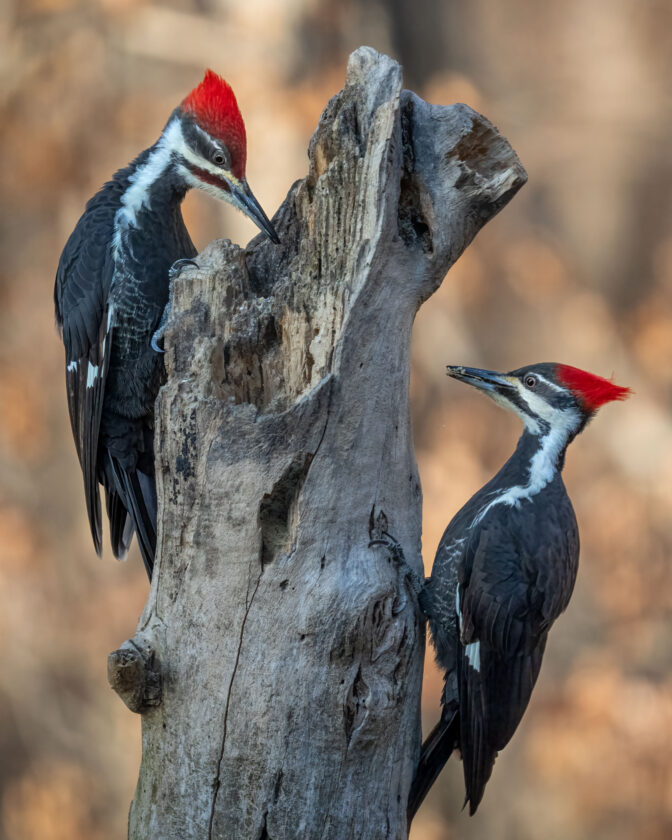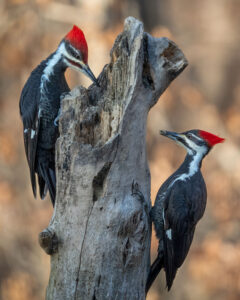Could it be possible that birds enjoy playing?

PHOTO PROVIDED Two pileated woodpeckers are shown on a stump in this photo by Brian Keenan which won an Audubon Photography Award in 2023.
My friend and I had just stepped out of May’s Drive-In late one October morning when she pointed to a large black bird on the telephone pole across the highway, near the east end of the Lewisburg river bridge.
Looking closer, we saw there were actually two crow-sized black birds, both with prominent red crests and white neck stripes. Clinging and climbing with their talons, they chased each other up, down and around the pole, frequently reaching over to jab with their bills.
Without binoculars, we couldn’t see whether either bird had the male pileated woodpecker’s narrow red cheek stripe. I knew pileated couples behave this way during courtship, but it wasn’t nesting time. What was going on here? I wanted answers.
My Stokes Guide to Bird Behavior explained that pileated woodpeckers’ territorial displays, in which birds may hitch around tree trunks, wave their bills, and peck at each other, happen year-round, whereas courtship behaviors, which can look the same, occur from mid-March to mid-May.
Pileated woodpecker pairs mate for life, maintaining the same territory year-round. Both sexes will defend their territory from other pileateds. These details suggested that my friend and I were watching a territorial dispute.
But that morning, the game went on so long that both birds seemed to be staying in it willingly. They were still at it when my friend grew tired of watching and we went on our way. I kept wondering, though: Could these birds be siblings who hadn’t yet gone off to find their own mate and territory, having a pretend fight?
Or empty-nest mates, enjoying a bit of flirting? Was this some kind of play?
Ornithologists have found examples of play in 13 of the 27 orders of birds. I’ve seen just a few: American crows on windy days, for example, sailing up high only to drop, surfing the wind, then winging back up to plunge again. Or the young common mergansers I watched at the fish ladder by the Fabridam near Sunbury this summer, lining up to ride a narrow chute of fast water formed by rocks at the edge of a little island, crowding back to the top after each ride to shoot the rapids again.
Scientists studying play in non-human animals need precise definitions, like this one from the Cornell Lab of Ornithology: “activities that enhance learning of motor and sensory skills and social behaviors but otherwise serve no immediate purpose.”
Personally I suspect that a bird — or other animal — is playing when no other explanation seems to fit, and they appear to enjoy it. It’s easy to find videos of animals at play such as elephants sliding down mudbanks or taking hats from people and placing them on their own heads, for example. Or just watch kittens or puppies for a while, or calves, or foals. Sure, those baby animals are practicing the behaviors of their kind — chasing, hunting, running, kicking — but doesn’t it look like fun?
I recently learned a term from psychology, borrowed from German: funktionslust, defined as the pleasure a human or other animal (in some definitions) takes in doing something they are meant to do, or something they do well. A runner’s pleasure in running is one example.
We’ve all felt it. What must it feel like to use the skills of a hummingbird, owl or eagle?
When I asked some knowledgeable friends about the pileated woodpeckers in October, they shared several examples of courtship-related behavior reappearing in the fall, when the day length is the same as when courtship begins in spring; spring peepers peeping and song sparrows singing, for instance. There’s a name for this behavior: the fall echo.
One friend quoted from a 1920 article by Charles W. Townsend in The Auk, an ornithological journal: “The autumnal recrudescence of the amatory instinct, often displayed in song, is well known.”
In Townsend’s day, it was customary to write about non-human animals as creatures motivated solely by instinct, not conscious choice. We’ve learned some things about animal minds since then.
Still, we will never know what it’s like to be a bird, and it’s all too easy to assume that their experiences and motivations are like ours, and vice versa. But for now, I’m going with my gut and leaving open the possibility that what my friend and I saw last year was a pair of pileated woodpeckers doing what pileated woodpecker pairs do on autumn days like that one, because they can, and because they enjoy it.
Sabrina Kirby lives near Lewisburg, birds with Seven Mountains Audubon, and enjoys imagining what it’s like to be a bird.


